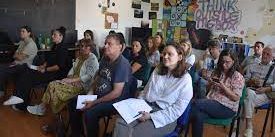At the online debate that took place within the Media Literacy Days , civil society organizations working at the local level debated the factors that hinder the inclusion of citizens with different forms of disabilities in the public sphere. The impetus for the debate was the findings of the latest research conducted by civil society organizations from the Eastern and Southeastern regions, in cooperation with the RESIS Institute.
One of the main conclusions from the debate was that sensory disability combined with age is a strong reason for the digital exclusion of a large number of citizens, and this in turn negatively affects their right and opportunities to participate in the public sphere and influence the political processes taking place. at the local and national level.
In the survey that was conducted with 451 respondents from both regions, the digital inclusion of vulnerable groups of citizens was measured through several indicators, of which the following stand out: the ability to use the Internet independently, the possession of skills to use smart technologies, access to assistive technology and the adaptability of media content and web pages so that they can be used by people with sensory disabilities.
The findings of the survey showed that sensory disability, especially visual impairment, is the biggest obstacle to using the Internet: the lowest percentage of respondents who go online independently are the visually impaired (31.5%), and they are also the citizens who most often need it help (20.2%) when using the internet. Hearing impairment is to a lesser extent an obstacle to using the Internet: 56.1% of respondents with hearing impairment stated that they can use the Internet independently, and only 6.1% need help from another person.
77.5% of visually impaired people lack computer skills the most, followed by people living with hearing impairment (56.1%). The skills to use a smartphone are again mostly lacking for people with visual impairment (58.4%), and slightly less for people with hearing impairment (47.5%). Of course, an additional reason for the lack of knowledge and skills in using technologies is the age of these categories of respondents.
Access to assistive technology for using modern communication devices is also an obstacle for these groups of citizens: 51.2% of the hearing impaired and 46.7% of the visually impaired stated that they do not have access to assistive technology. Of those respondents who use the Internet, a large percentage stated that the Web pages are not suitable for people with sensory disabilities: 62.2% for people with hearing impairment and 51.7% for people with visual impairment.
In the survey, respondents with sensory disabilities also stated whether they have difficulty watching television (without subtitles or audio description): 51.2% of respondents with hearing impairment said that it is difficult for them to watch television without subtitles, and 46. 7% of the visually impaired respondents said that they cannot follow certain contents because they do not have an additional audio description of the action.
The representatives of the civil society organizations also discussed the positive experience of the work of the online platform LocalActiv and emphasized the importance of the online media of the community for informing the citizens and for their inclusion in the local pluralistic democracy.
The survey was conducted by the RESIS Institute and 13 civil society organizations from the Eastern and Southeastern regions that are members of the online platform LocalActive, which was established with the support of the National Endowment for Democracy from the USA (NED) Democracy from the USA (NED) within the framework of the project “Encouraging Civic Engagement in local government”.
You can watch the video of the debate here.






